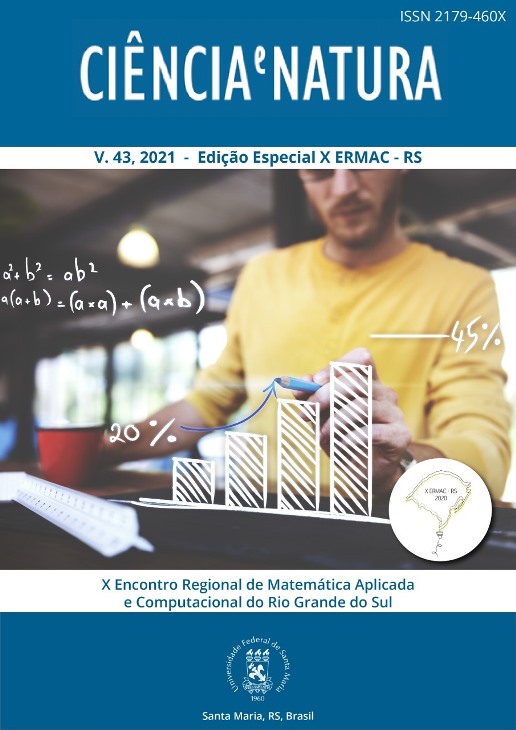Mathematical modeling in quantification of [18F] FDG positron emission tomography images
DOI:
https://doi.org/10.5902/2179460X66979Palavras-chave:
Radiotracer, positron emission tomography (PET), reference region, kinetic modeling.Resumo
Techniques for locating and quantifying brain glucose metabolism using compartmental modeling by solving systems of differential equations ordinary require an input function (input function), Ca(t). To avoid invasive procedures, such as collecting arterial blood samples, it is possible to obtain Ca(t) of the first order ordinary differential equation Cr´(t) = K1Ca(t)-K2Cr(t), where Cr(t) describes the concentration of the radiopharmaceutical in a reference region. Cr(t) is built from data obtained by processing images generated by positron emission tomography (PET) with radiotracers. In this work, the carotids were chosen as the reference region, and regression techniques were applied seeking to adjust the discrete activity curves (TAC) data obtained by PET imaging with the radiopharmaceutical fluorodeoxyglucose [18F]FDG. Aiming to find the same model type for all patients, the picewise linear function proved to be adequate to describe four stages of the behavior of the Cr(t) concentration: rapid growth and degrowth, intermediate and slow degrowths.Downloads
Referências
Borelli, W. V. (2019). Correlação Entre Neuroimagem Molecular, Estrutural e Funcional em Superidosos. 143 f. Thesis (Doctorate) Programa de Pós-Graduação de Medicina e Ciências da Saúde da Pontifícia Universidade Católica do Rio Grande do Sul. Porto alegre.
Hauser,E.B.,Venturini,G.T.,Greggio,S.,Borelli,W.V.,Costa,J.C.(2019).Carotidarterialinputfunctionasaninverseproblem in kinetic modeling of [18]2−fluoro−2deoxy−Dglucose(FDG). Computer Methods in Biomechanics and Biomedical Engineering: Imaging & Visualization, 8, 2168-1171.
Hauser, E. B., Borelli, W. V., Costa, J. C. (2020). Biomechanical Model Improving Alzheimer’s. Disease. In: Redha Taiar, editor. Recent Advances in Biomechanics 77–91.Intech Open.
Oliveira, F. (2019). Modelo Logístico para Descrever as Atividades de Curvas Discretas Obtidas de Imagens PET com Radiofármaco[18F]FDGnumVolumedeInteressedasCarótidas.. 28 f. Dissertation (Lato sensu) Pontifícia Universidade Católica do Rio Grande do Sul Porto Alegre.
Downloads
Publicado
Versões
- 2022-07-14 (3)
- 2022-04-06 (2)
- 2021-11-08 (1)
Como Citar
Edição
Seção
Licença
Copyright (c) 2021 Ciência e Natura

Este trabalho está licenciado sob uma licença Creative Commons Attribution-NonCommercial-ShareAlike 4.0 International License.
Para acessar a DECLARAÇÃO DE ORIGINALIDADE E EXCLUSIVIDADE E CESSÃO DE DIREITOS AUTORAIS clique aqui.
Diretrizes Éticas para Publicação de Revistas
A revista Ciência e Natura está empenhada em garantir a ética na publicação e na qualidade dos artigos.
A conformidade com padrões de comportamento ético é, portanto, esperada de todas as partes envolvidas: Autores, Editores e Revisores.
Em particular,
Autores: Os Autores devem apresentar uma discussão objetiva sobre a importância do trabalho de pesquisa, bem como detalhes e referências suficientes para permitir que outros reproduzam as experiências. Declarações fraudulentas ou intencionalmente incorretas constituem comportamento antiético e são inaceitáveis. Artigos de Revisão também devem ser objetivos, abrangentes e relatos precisos do estado da arte. Os Autores devem assegurar que seu trabalho é uma obra totalmente original, e se o trabalho e / ou palavras de outros têm sido utilizadas, isso tem sido devidamente reconhecido. O plágio em todas as suas formas constitui um comportamento publicitário não ético e é inaceitável. Submeter o mesmo manuscrito a mais de um jornal simultaneamente constitui um comportamento publicitário não ético e é inaceitável. Os Autores não devem submeter artigos que descrevam essencialmente a mesma pesquisa a mais de uma revista. O Autor correspondente deve garantir que haja um consenso total de todos os Co-autores na aprovação da versão final do artigo e sua submissão para publicação.
Editores: Os Editores devem avaliar manuscritos exclusivamente com base no seu mérito acadêmico. Um Editor não deve usar informações não publicadas na própria pesquisa do Editor sem o consentimento expresso por escrito do Autor. Os Editores devem tomar medidas de resposta razoável quando tiverem sido apresentadas queixas éticas relativas a um manuscrito submetido ou publicado.
Revisores: Todos os manuscritos recebidos para revisão devem ser tratados como documentos confidenciais. As informações ou ideias privilegiadas obtidas através da análise por pares devem ser mantidas confidenciais e não utilizadas para vantagens pessoais. As revisões devem ser conduzidas objetivamente e as observações devem ser formuladas claramente com argumentos de apoio, de modo que os Autores possam usá-los para melhorar o artigo. Qualquer Revisor selecionado que se sinta desqualificado para rever a pesquisa relatada em um manuscrito ou sabe que sua rápida revisão será impossível deve notificar o Editor e desculpar-se do processo de revisão. Os Revisores não devem considerar manuscritos nos quais tenham conflitos de interesse resultantes de relacionamentos ou conexões competitivas, colaborativas ou outras conexões com qualquer dos autores, empresas ou instituições conectadas aos documentos.






